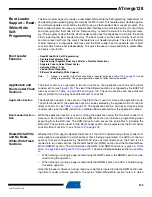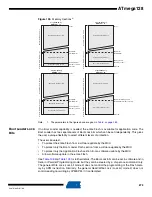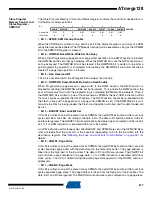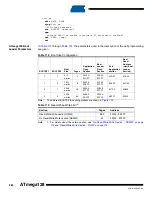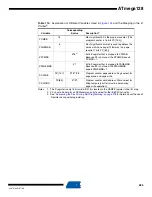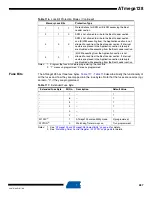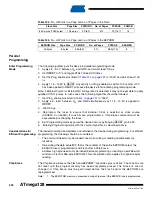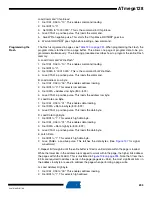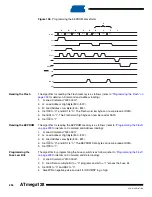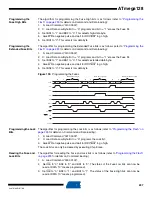
282
2467S–AVR–07/09
ATmega128
Fuse and Lock bits that are programmed, will be read as zero. Fuse and Lock bits that are
unprogrammed, will be read as one.
Preventing Flash
Corruption
During periods of low V
CC,
the Flash program can be corrupted because the supply voltage is too
low for the CPU and the Flash to operate properly. These issues are the same as for board level
systems using the Flash, and the same design solutions should be applied.
A Flash program corruption can be caused by two situations when the voltage is too low. First, a
regular write sequence to the Flash requires a minimum voltage to operate correctly. Secondly,
the CPU itself can execute instructions incorrectly, if the supply voltage for executing instructions
is too low.
Flash corruption can easily be avoided by following these design recommendations (one is
sufficient):
1.
If there is no need for a Boot Loader update in the system, program the Boot Loader Lock
bits to prevent any Boot Loader software updates.
2.
Keep the AVR RESET active (low) during periods of insufficient power supply voltage.
This can be done by enabling the internal Brown-out Detector (BOD) if the operating volt-
age matches the detection level. If not, an external low V
CC
Reset Protection circuit can
be used. If a Reset occurs while a write operation is in progress, the write operation will
be completed provided that the power supply voltage is sufficient.
3.
Keep the AVR core in Power-down Sleep mode during periods of low V
CC
. This will pre-
vent the CPU from attempting to decode and execute instructions, effectively protecting
the SPMCSR Register and thus the Flash from unintentional writes.
Programming Time for
Flash when Using
SPM
The calibrated RC Oscillator is used to time Flash accesses.
shows the typical pro-
gramming time for Flash accesses from the CPU.
Simple Assembly
Code Example for a
Boot Loader
;-the routine writes one page of data from RAM to Flash
; the first data location in RAM is pointed to by the Y pointer
; the first data location in Flash is pointed to by the Z-pointer
;-error handling is not included
;-the routine must be placed inside the boot space
; (at least the Do_spm sub routine). Only code inside NRWW section can
; be read during self-programming (page erase and page write).
;-registers used: r0, r1, temp1 (r16), temp2 (r17), looplo (r24),
; loophi (r25), spmcsrval (r20)
; storing and restoring of registers is not included in the routine
; register usage can be optimized at the expense of code size
;-It is assumed that either the interrupt table is moved to the Boot
; loader section or that the interrupts are disabled.
.equ PAGESIZEB = PAGESIZE*2
;PAGESIZEB is page size in BYTES, not words
.org SMALLBOOTSTART
Write_page:
; page erase
ldi
spmcsrval, (1<<PGERS) | (1<<SPMEN)
call
Do_spm
; re-enable the RWW section
ldi
spmcsrval, (1<<RWWSRE) | (1<<SPMEN)
call
Do_spm
Table 111.
SPM Programming Time.
Symbol
Min Programming Time
Max Programming Time
Flash write (page erase, page write,
and write lock bits by SPM)
3.7 ms
4.5 ms
Содержание ATmega128
Страница 384: ...vi 2467S AVR 07 09 ATmega128 Rev 2467C 02 02 377 Table of Contents i...
Страница 385: ...vii 2467S AVR 07 09 ATmega128...






